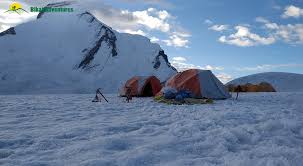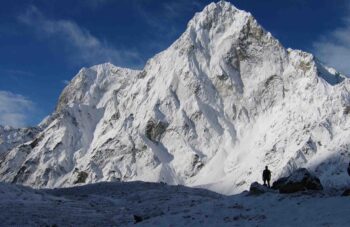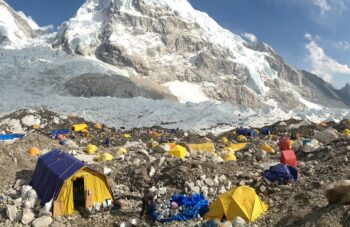Mount Pumori Expedition 7161M
Overview
The Mount Pumori Expedition is an exhilarating and challenging adventure that takes mountaineers to the breathtaking Himalayas. Standing at 7,161 meters (23,494 feet) above sea level, Mount Pumori is located in the Khumbu region of Nepal, near the iconic Mount Everest. This expedition offers a unique opportunity to conquer a formidable peak and experience the awe-inspiring beauty of the world’s highest mountain range.
The journey begins in Kathmandu, Nepal’s vibrant capital, where participants will undergo a thorough briefing and equipment check. The expedition is led by seasoned mountaineers and expert Sherpas, ensuring a safe and successful ascent.
The trek to the base camp is a mesmerizing experience, passing through lush forests, quaint Sherpa villages, and ancient monasteries. Once at the base camp, climbers acclimatize and undergo essential training, preparing them for the challenging climb ahead.
The ascent involves navigating through treacherous crevasses, icefalls, and steep ridges, making the climb technically demanding and physically rigorous. However, the reward is extraordinary, with awe-inspiring panoramic views of Everest, Lhotse, and Nuptse gracing the horizon.
Climbers will face various camps as they progress upwards, each providing a vital resting point for acclimatization. The final push to the summit requires both determination and teamwork, and reaching the top offers an overwhelming sense of achievement.
The descent demands equal focus and care, as climbers must negotiate the same challenging terrain. Back at the base camp, a celebration awaits, marking the triumph of conquering Mount Pumori.
The entire expedition typically takes around 4-6 weeks, including acclimatization periods. It is recommended for experienced climbers with prior high-altitude experience. Safety remains a top priority throughout the journey, with proper acclimatization and weather conditions being closely monitored.
Conclusion and Summary
Overall, the Mount Pumori Expedition is an unforgettable experience that pushes physical and mental limits, offering participants a chance to create lifelong memories and witness the unparalleled beauty of the Himalayas.
Itinerary
-
DAY 1: Arrival In Kathmandu And Transfer To The Hotel
-
Day 2: Official Formalities And Documentation
The next day, we will start our preparation for our expedition. We will now pack our bags, do some necessary shopping, re-check everything that we need (Especially medicines and essentials). Briefings will be made about every aspect of the expedition and all gears and equipment, trip duration, accommodation, facilities at the base camp, and all related to the expedition. It is also an opportunity for you to communicate and introduce yourself to your fellow climbers and teammates.
-
Day 3: Fly To Lukla And Trek To Phakding (2610 M)
-
Day 4-5: Trek To Namche And Acclimatize (3,440 M)
-
Day 6: Trek To Tengboche (3,860 M)
-
Day 7-8: Trek To Dingboche And Acclimatize (4410 M)
-
Day 9: Trek To Lobuche (4910 M)
-
Day 10-12: Trek To Pumori Base Camp (5300M)
-
Day 13-30: Climbing Period Of Mount Pumori
Camp I will be set up at an altitude of 5,650 m while Camp II will be set up at 6000 m right at the ridge after the phase. Then, to make the summit push easier, we will set up our Camp III at 6,500 m. On the day of the summit push, we start early so that we exploit the opportunity to witness the glorious sunrise behind the giant white peaks. The top of Mt. Pumori gives and exceptional panoramic views of Mt. Everest, Mt. Lhotse, Mt. Nuptse, Mt Makalu, Ama Dablam, Lobuche Peak, Mt. Cho Oyu, and many other snow-capped peaks.
After some time of amazement, we retrace our path back to lower camps.
-
Day 31: Trek Back To Pheriche
-
Day 32: Trek Back To Namche Bazaar
-
Day 33: Trek Back To Lukla
-
Day 34: Fly To Kathmandu, Explore The City
-
Day 35: Final Departure
With gratitude and best wishes, we will have to bid you farewell for your flight back home. We hope to see you soon in the next season for a brand new adventure. One of our representatives will drop you off at the airport 3 hours prior your scheduled departure
Include / Exclude
Cost Includes:
-
- International and Domestic Airport-Hotel-Airport transfers in Nepal
- Hotel accommodation in hotel in Kathmandu on bed/breakfast
- Schedule flight Kathmandu-Lukla-Kathmandu for climbing members, Liaison Officer, and Staff
- Member personal climbing equipment Kathmandu-Lukla-Base Camp-Kathmandu (max 60 kg
- Full Board food, lodging during trekking to base camp and back to Lukla after Expedition
- A professional climbing Sherpa guide per 2 members during summit attempt and during climbing
- 4 Oxygen cylinders per member with top-out Mask and Regulator.
- All staff KTM-Base Camp-KTM transportation
- Common climbing equipment (necessary rope, ice bars, ice screws, etc.
- Clean Mountain bags
- Solar Power at Base Camp and Camp II.
- Satellite Phone available at Base Camp ( with nominal charge per use)
- The facility of Internet service and recharge cards with a nominal charge
- Daily Weather Report Services
- Medical consultation services at the Base Camp with the (HRA) clinic
- High Altitude tents: Single Tent in the Base Camp while in upper camps, the tent shall be shared with 2-3 climbers
- All food and fuel for Base Camp and higher camps during Expedition as per the schedule
- Services of cook and kitchen boy at Base Camp and Cook at Camp II.
- Kitchen tent, Stores tent, Dining Tents, Toilet Tents, Shower Tent, Tables and chairs, cooking utensils for Base Camp and camp II,
- Insurance for Climbing Sherpas, Cooks, Liaison Officer, and local porters as well as Equipment,
- Allowances and wages for Climbing Sherpas, cooks, kitchen boys, and Government Liaison Officers.
- Base Camp single tent with mattress and pillow for each member, Climbing Sherpa, BC staffs, and Liaison Officer Tents
- Solar panel at Base Camp for light and charging small electronics. (Eg. mobile phones, amateur digital cameras, and handheld video cameras).
- Personal solar-powered light at each tent per member at the Base Camp in the evening,
- Transportation of food and equipment supply to Base Camp from Kathmandu (Cargo to Lukla and then by porter or Yaks to Base Camp
- Heaters in the base camp in the dining tent
- Fresh vegetable supply from Namche bazaar or Kathmandu
- Special high foods for members and sherpas as per requirements of your choice in Kathmandu
- Summit and Higher Camp Route fix charge,
- Applicable National Park fees and local taxes (VAT 13%) imposed by Nepal government,
- Emergency oxygen during the expedition in the Base Camp and Higher Camps,
- First Aid kit ( For special medicine or internal medicine please seek advice from your doctor and prepare accordingly),
- Garbage deposit Shipment Charges
- Company service charge
- Mt. Pumori Expedition Royalty fee and all official formalities of all documents for climbing Mt. Pumori
Cost Excludes:
- International flight tickets from/to your country.
- Nepal Entry visa fee that can be obtained at the airport upon arrival,
- Lunch and Dinner during the stay in Kathmandu.
- An extended stay in a hotel in Kathmandu.
- Your Personal Climbing Equipment,
- Extra cost incurred due to Personal member’s baggage exceeding 60 k.g,
- Buy special Insurance such as travel, accident, medical, emergency evacuation by helicopter in case of need during the Pumori Expedition
- Charges for Commercial Filming and Drone Permit if needed,
- International airport departure tax at Kathmandu Airport.
- Expenses of a personal nature such as hard and soft drinks, laundry, postage, telephone, wifi, etc,
- Extra oxygens other than 4 bottles,
- Climbing Sherpa summit bonus
- Tips for staffs cook in the Base Camp
- Camp 2 cook tips
- Any other extra expenses other than mentioned in the Cost Includes section,
- Any unforeseeable risks that can arise during the mountaineering,
Price per person
Usefull Information
The first successful ascent to this stunning peak was made in 1962 by Gerhard Lesner from a German-Swiss expedition team. Since then, numerous summits have been made but the first winter ascent to Pumori was only made in 2017 by Ali Sadpara from Pakistan.
The Pumori expedition starts with a flight from Kathmandu to Lukla and then trekking through beautiful villages in Phakding, Namche Bazaar, Tengboche, Lobuche, and Gorakshep. The trek allows is to experience the rural and local lifestyle of Sherpas. We get to pass through picturesque villages with terraced farmlands, dense forests of Rhododendron and Pine slowly rising towards rocky landscapes with no vegetation. We finally reach the base camp where we prepare for the climb.
The climb to Mt. Pumori requires traversing many snow-covered ridges and climbing across numerous glaciers. At times, climbers need to climb over slopes rising about 40-60 degrees, which is very technical and requires proper mountaineering experience.
Due to the technicalities involved, several camps will be established before actually pushing for the Summit. The base camp is established at 5300m followed by Camp I at 5650 m. Then, ascending on 40-60 degrees slopes we reach Camp II at 6200 m. Further, walking on more ice and snow, we will rest at Camp III at 6500 m before heading to the Summit at 7,161m. Our highly experienced Sherpas will set up fixed ropes and routes to help you ascend and descend easily. Our food and accommodations are top-notch making every moment of your travel worth it.
The summit of Pumori showcases an amazing panoramic view of Mt Everest, Mt Lhotse, Mt Nuptse, Mt Cho Oyu, Mt Makalu, and many other snow-capped peaks. As we start early in the morning, we may be lucky enough to witness the glorious sunrise that lightens up the white snow into golden making the scene unreal.
The best season to go on an expedition to Mt. Pumori is Spring (March – June) and Autumn (August- November)
Equipment List
FAQs
-
 Best Seasons March to May, September to November
Best Seasons March to May, September to November -
 Group Size 2-15
Group Size 2-15 -
 Duration 35 DAYS BOOKING OPEN
Duration 35 DAYS BOOKING OPEN -
 Maximum Altitude 7161M
Maximum Altitude 7161M -
 Trek Difficulty Challenging
Trek Difficulty Challenging







